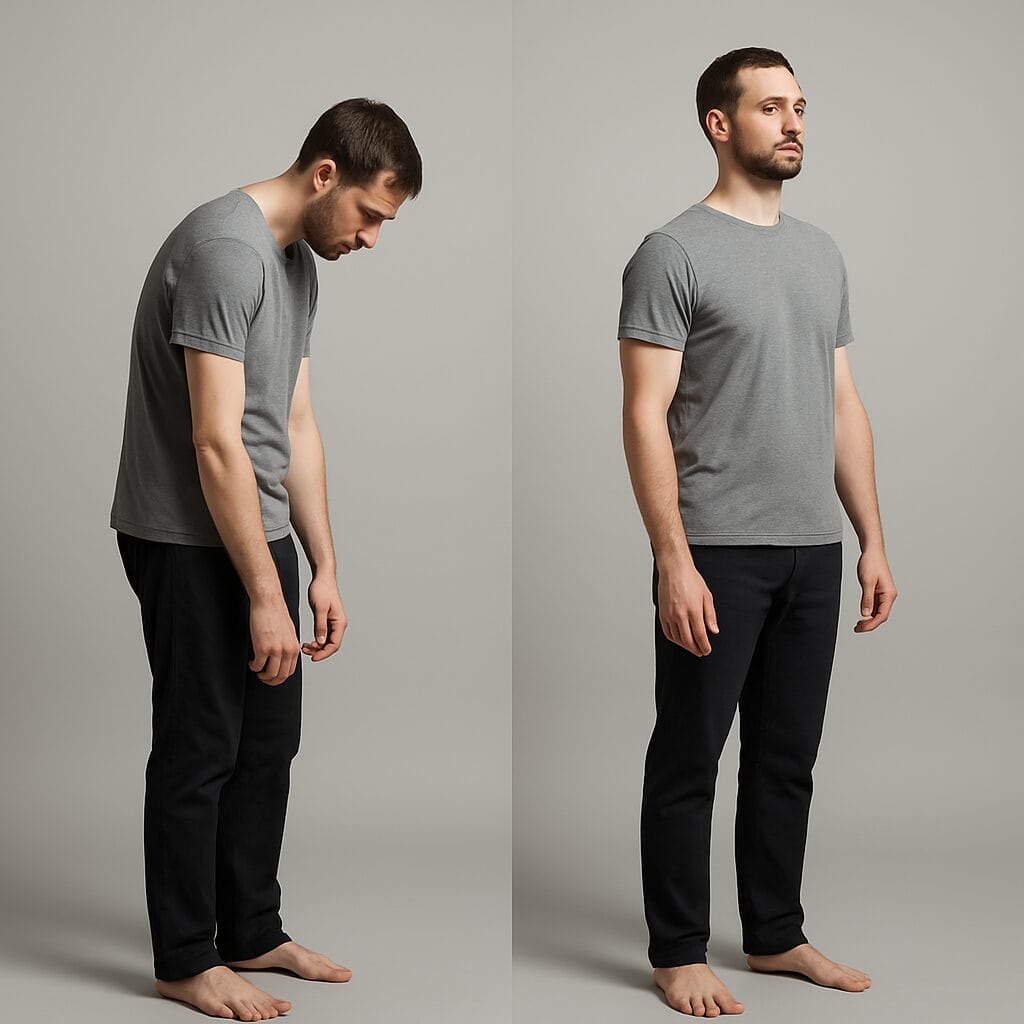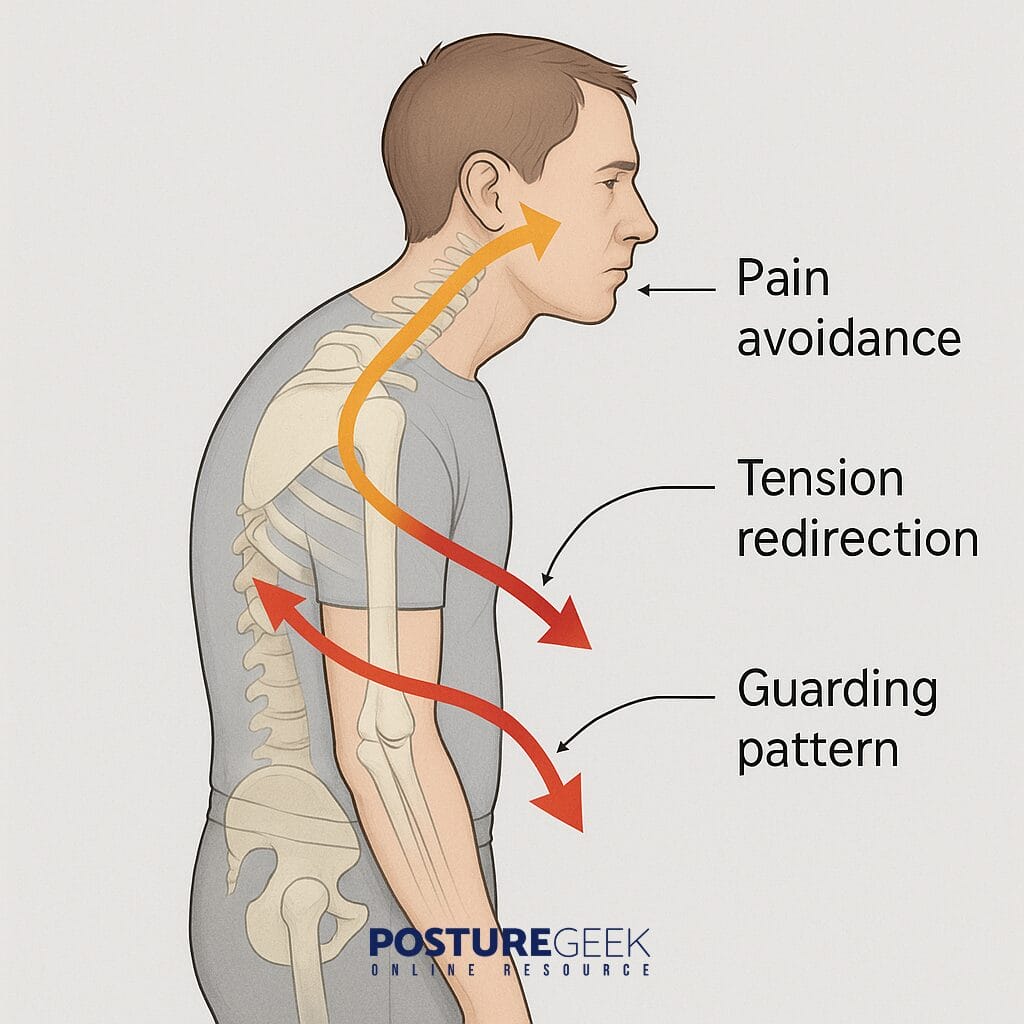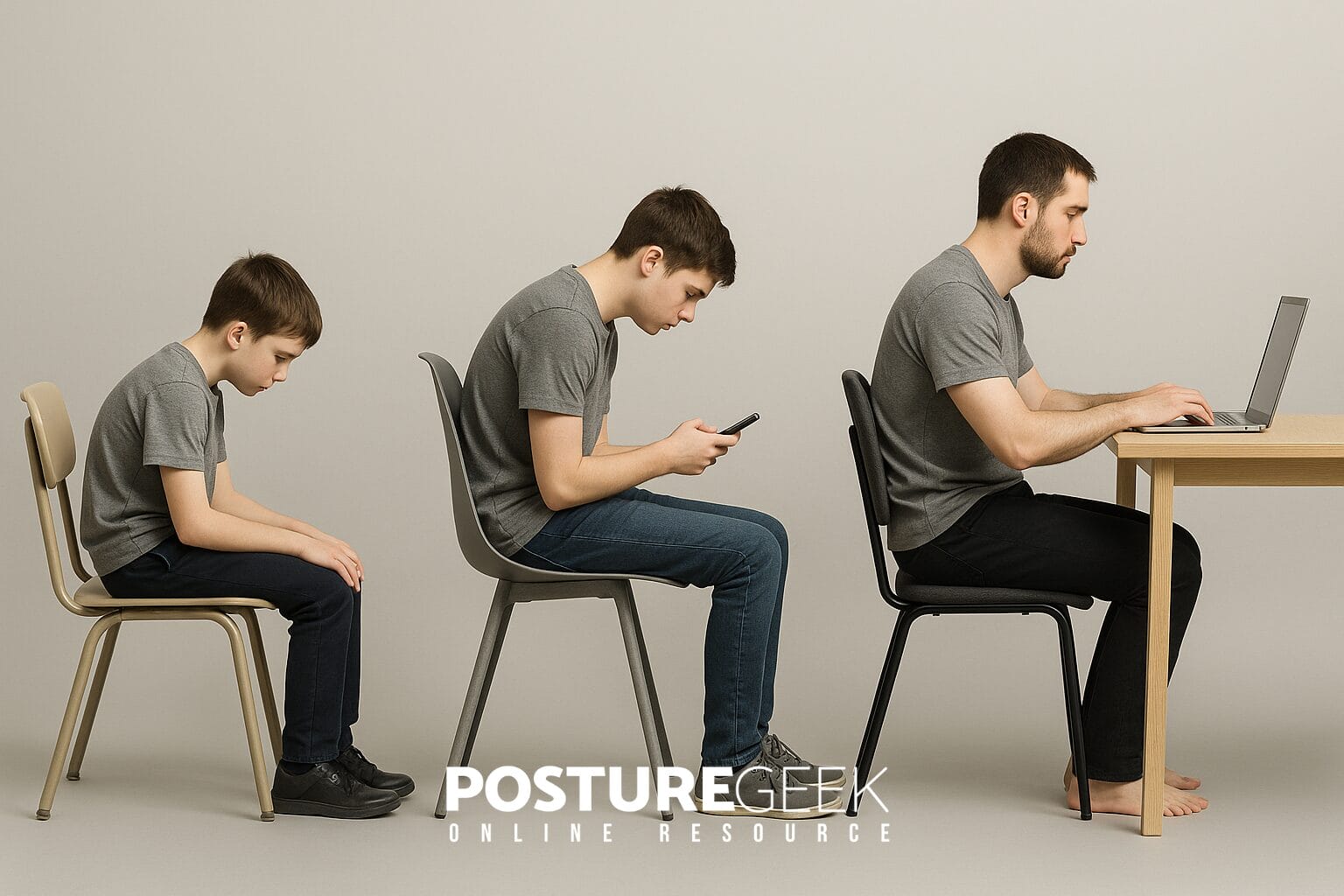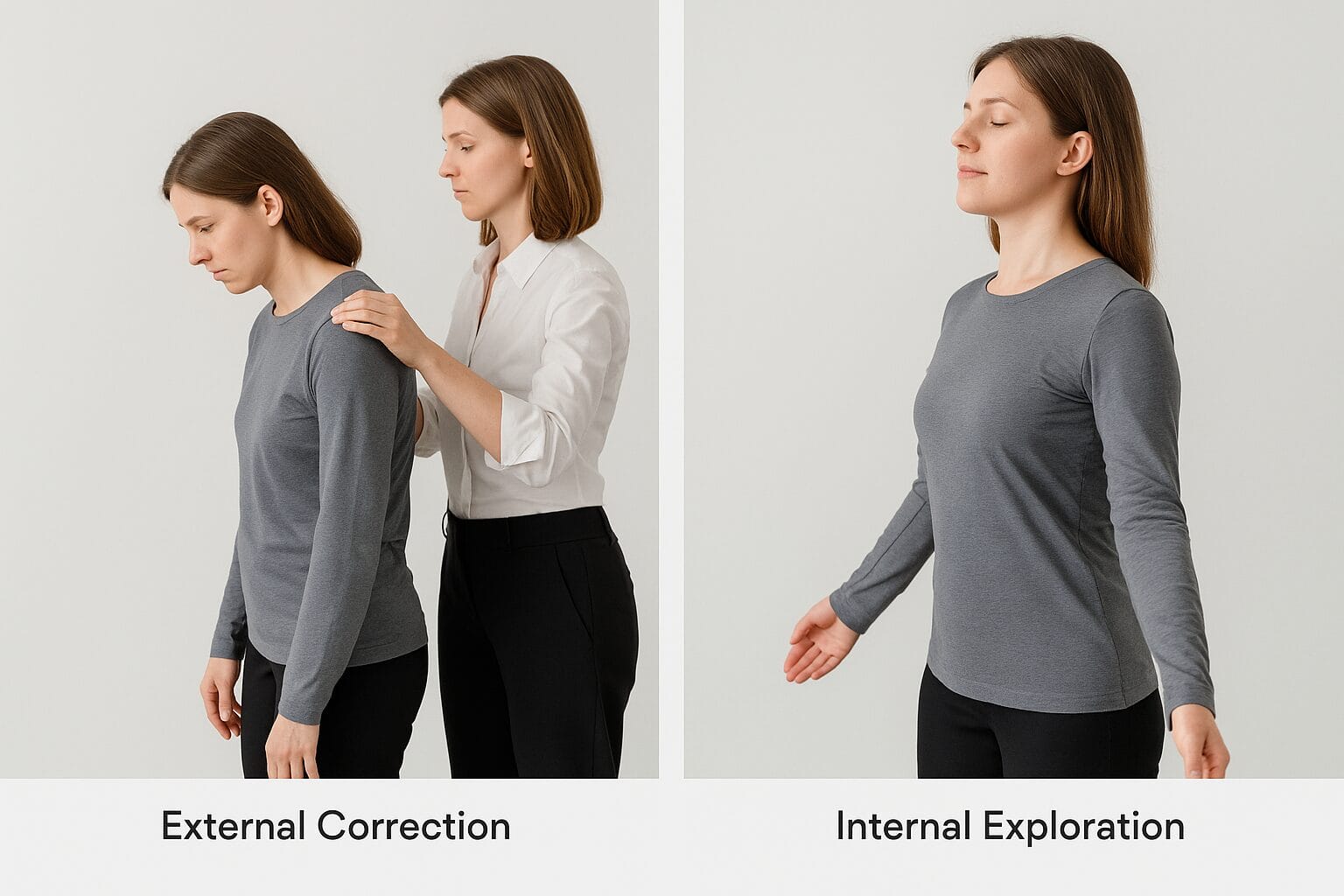Why Do Humans Slouch? The Real Story Behind Slouching Posture
- Updated - July 24, 2025

We often associate slouching posture with signs of laziness or physical weakness.
Straighten up, we’re told. Engage your core. Pull your shoulders back.
But if it were that simple, everyone would walk tall after one good cue.
The truth is, slouching posture is not just a physical flaw. It’s a learned, adaptive response to modern life.
It’s shaped by long-term influences that go far beyond weak muscles or poor habits.
It’s not a defect to correct, but a pattern to understand.
To achieve lasting change, we must go beyond alignment drills and muscle fixes.
Because slouching isn’t just about what the body is doing, it’s about the systems that govern it.
1. Muscular Imbalance Isn't the Whole Story
When it comes to slouched posture, the most common explanation still centers around muscular imbalance. You’ve heard the list:
- Tight hip flexors
- Weak or inhibited glutes
- Lazy spinal extensors
- Overactive pecs
- Underactive lower traps
These patterns recur repeatedly, and they’re not without merit. But they’re often misunderstood.
They’re not causes. They are consequences.
Muscles Don't Malfunction in Isolation
Muscles don’t just forget how to work. They respond to patterns of use, behavior, and demand.
A weak posterior chain isn’t inherently dysfunctional. It may simply be underutilized.
Tight hip flexors aren’t defective. They’ve been placed in a shortened position for hours every day and have adapted accordingly.
The body always responds to the signals it receives. And if your daily environment consistently reinforces flexion, stillness, or asymmetry, your muscles will adapt accordingly.
This isn’t failure. It’s efficiency.
Discover a practitioner near you.
Looking for a practitioner near you? Our extensive network of qualified professionals is here to help you.
Slouched Posture Is a Pattern, Not Just a Strength Deficit
Many people can build strength in the right muscles but still default to a slouching posture throughout the day.
Why?
Because posture isn’t just driven by available strength. It’s governed by automatic, low-effort patterns reinforced over time.
You can have strong glutes and still tuck your pelvis under every time you sit.
You can strengthen your thoracic extensors and still round your shoulders the moment your attention drifts.
This happens not because the exercises failed, but because the posture pattern was never retrained. The nervous system didn’t update its default setting.
The Nervous System Prioritizes Familiarity Over Force
Your body will always choose the most familiar, energy-efficient pattern. That’s rarely the one you just built in the gym.
Unless posture awareness is practiced in real-world contexts, with variability and awareness, the old pattern remains dominant.
Muscular correction alone often fails because it addresses the what, not the why.
Muscle strength matters. But without nervous system retraining, it’s like installing a new engine without updating the software.
We’re not abandoning strength, mobility, or alignment work. We’re expanding the lens, so those tools land more effectively.
Correcting the Pattern Means Going Deeper
If we want to influence slouched posture in a lasting way, we have to ask better questions:
- Why did this pattern form in the first place?
- What demand, environment, or emotion shaped it?
- How can we help the nervous system trust a new pattern, not just force one?
The muscles are not the origin of the problem. They are the messengers.
And unless we look beyond the muscular surface, the same slouching behavior will continue to re-emerge.
2. Emotion and Posture: The Nervous System Speaks
Slouching doesn’t just reflect your structure.
It reflects your state.
Grief compresses the chest.
Shame draws the head down.
Chronic stress pulls us into protective flexion.
Shallow breathing, narrowed vision, and collapsed posture often walk hand in hand.
This is the nervous system doing its job, organizing the body to feel safer, smaller, less vulnerable.
Trying to force someone into a more “upright” position without addressing these underlying drivers can increase tension, not resolve it.
Real change in slouching posture begins with nervous system regulation:
- Breathwork
- Movement that supports expansion, not correction
- Trauma-informed approaches
- Gentle integration instead of forced “fixes”
Until you address the emotional and neurological underpinnings, the slouched posture remains a safe default.
3. Compensation and Pain: The Body Protects Itself

Not all slouching posture is dysfunctional.
Sometimes it’s protective.
The body constantly finds ways to move around pain.
If a joint hurts, if there’s an old injury, or if the system senses instability, posture adapts. Often by slouching or shifting.
For example:
- A collapsed thorax may protect the ribs during breathing.
- Rounded shoulders may reduce strain on a damaged rotator cuff.
- A forward head position might offload tension from the upper spine.
In these cases, slouching is not a sign of weakness. It’s a strategy.
Trying to eliminate slouching without understanding what it’s guarding is like muting a fire alarm without checking for smoke.
Before correcting the posture, ask:
“What is this slouch position protecting?”
“What would happen if we removed it?”
Your job isn’t necessarily to restore ideal alignment. It’s to help the body feel safe enough to self-correct.
4. The Biggest Influence on Slouching? Habit and Culture
When people talk about slouched posture, they often focus on individual mechanics. But one of the most powerful forces shaping posture is not internal at all. It’s external.
It’s culture.
It’s repetition.
It’s environment.
Slouching posture is often not a mistake or failure. It’s something we are trained into: day by day, hour by hour, year by year.
We Learn to Slouch Early
From the moment we enter school, our bodies begin to receive the same message over and over again: stay still, sit down, stop moving.
- Classroom desks are built for stillness, not movement.
- Children are told to face forward, with their heads down and shoulders relaxed.
- Chairs often don’t fit developing bodies, forcing them to collapse and brace.
What begins as an inconvenience becomes the start of a motor habit. One that, left unchecked, continues into adulthood.
Modern Devices Reinforce Forward Flexion
Technology has made things easier, but it has also made us smaller.
Phones, tablets, and laptops change the way we hold our bodies. They shrink our field of vision and pull our heads forward.
- The chin juts out to focus on small screens.
- The neck lengthens and flexes.
- Shoulders roll forward to bring the hands into view.
- Breathing becomes shallow.
None of this is inherently harmful in short doses. The problem is that these patterns are repeated on a daily basis. And the nervous system adapts accordingly.

Our Environment Trains Our Nervous System
Posture is not just about muscle tone or bone position. It is about what the body gets used to.
If your environment consistently asks you to:
- Sit with your hips below your knees
- Reach forward more than upward
- Look down more than ahead
- Remain still more than you move
- Then, your nervous system will adapt to those inputs.
The longer those inputs persist, the more permanent the output becomes.
Social Cues Shape Physical Expression
It’s not just furniture and technology.
Slouched posture is also shaped by social context and emotional messaging.
- People who feel anxious or unsure tend to shrink inward.
- Those taught to be deferential may unconsciously round their shoulders and lower their gaze.
- Social pressure to avoid taking up space often results in physical contraction.
We are not just postural beings. We are social beings.
And posture often reflects how we are taught to fit in, be quiet, or stay small.
The Slouch Becomes the Baseline
Over time, these combined influences create a powerful feedback loop.
The nervous system stops questioning the pattern. It becomes familiar. Safe. Efficient.
The body does not differentiate between optimal and habitual. It simply follows what it knows.
In neurological terms:
What fires together, wires together.
Slouching posture, practiced long enough, becomes the default setting.
Why Cueing Upright Posture Rarely Works
When someone has spent years or decades in a collapsed posture, a cue to “sit up straight” rarely sticks. It might work for a few seconds or minutes, but it feels foreign. It feels like effort.
That’s not because the person is unmotivated or unaware of the situation.
It’s because their body has adapted to a completely different context.
Without addressing the influences that created the posture, there’s nothing for the nervous system to anchor a new one to.
Posture Is Cultural and Contextual
You cannot fully understand or change a slouched posture without considering the culture that gave rise to it.
- Posture reflects the environment
- Posture reflects habit
- Posture reflects messaging
That means long-term change doesn’t come from cues alone.
It comes from reshaping the environment, introducing variety in movement, and giving people permission to expand again.
5. Why Slouching Posture Matters for Practitioners
If you are a health, movement, or bodywork professional, understanding slouching posture through this broader lens changes everything.
You are not just correcting alignment.
You are engaging with someone’s lived experience, nervous system, and long-term adaptation.
You are not fixing a position. You are unpacking a pattern.
This is not just a shift in method. It is a shift in mindset.
You Are Not Correcting a Fault. You Are Decoding a Story.
Slouched posture is not a mechanical defect. It is a story the body has learned to tell over time.
It can reflect stress, protection, habit, injury history, emotional suppression, or even social adaptation.
That means posture is not just about “what is wrong” but about why the body organized itself this way in the first place.
Your job is not to impose a new shape but to understand the existing one.
The Body Needs to Feel Safe Before It Can Expand
For many clients, slouching posture is not merely a habit; it is a significant issue. It is protective.
Trying to force someone into an upright position before their body trusts it can lead to more tension, not less.
A braced “upright” position may look better, but it can still be rigid and disconnected.
Actual postural change comes from internal permission, not external pressure.
That means the nervous system must feel supported before it is willing to reorganize.
Awareness Comes Before Alignment

Too often, posture correction skips a step.
It jumps from observation to instruction, without asking the person to sense what is happening in their body.
Lasting change starts with awareness.
- Where is the weight being held?
- What does upright feel like, compared to collapsed?
- Can they notice the shift in breath or energy between positions?
When someone becomes curious about their posture, they take an active role in improving it.
And that is more powerful than any cue you can give.
Context Shapes Form
Instead of chasing ideal alignment, help your clients explore how posture shifts with:
- Stress
- Emotion
- Environment
- Purpose
- Self-perception
The posture that appears in the clinic is not always the same as the one that shows up at work, at home, or under pressure—what is often called “bad posture”.
Bring context into the conversation. Help them see how their posture reflects more than just muscle tone.
It reflects how they relate to the world.
Let Go of the Ideal, Embrace Curiosity
Rigid ideals about “perfect posture” do more harm than good.
They create pressure, judgment, and frustration.
Instead, invite curiosity.
- What happens when you move this way?
- How does this position feel over time?
- What small change feels easier, more sustainable?
Encourage exploration, not obedience.
This makes posture work empowering rather than performative.
Your Role Is to Create a Space for Change
Clients do not need perfect cues.
They need permission to try something different.
They need guidance that is supportive, not corrective.
And they need someone who sees their posture not as a problem to be “fixed”, but as a message to be understood.
When you shift your lens from “fixing posture” to “facilitating awareness and adaptability,” your impact deepens.
So, Why Do We Slouch?
Slouched posture is not the result of laziness or a lack of discipline. It is not simply a matter of poor strength or incorrect alignment.
We slouch because the body, in its wisdom, has adapted.
We slouch because we have protected ourselves.
We have responded to stress, stillness, social pressure, and repetition.
We have been trained, often without realizing it, to collapse inward.
This is not failure. It is survival.
Slouching Is the Body's Most Efficient Solution
When you look at slouched posture through the lens of adaptation, everything changes.
The body always chooses the most energy-efficient, safe-feeling pattern available at the time.
If collapsing the chest, rounding the shoulders, or tucking the pelvis helped conserve effort, reduce threat, or match the environment, the nervous system recorded it as the preferred strategy.
The longer we employ that strategy, the more deeply it becomes ingrained.
Eventually, it stops feeling like a choice. It becomes the default.
Going Deeper Than Muscle Correction
Trying to change slouching posture through mechanical correction alone misses the point.
Yes, strengthening underactive muscles can help.
Yes, restoring mobility can lead to better posture.
But our posture is not just physical. It is also emotional, neurological, and behavioral.
To create lasting change, we must go beyond physical correction and explore the systems that made slouching feel necessary in the first place.
That means looking at:
- The nervous system and its response to safety and threat
- The environment that shaped daily behavior
- The emotional patterns embedded in the body’s movements
- The habits and repetitions that reinforced the collapse
Without addressing these, the slouched posture will always return, because it was never just about the body. It was about the body’s experience.
Offering a Better Option, Not Forcing a New One
The goal is not to force someone to “stand up straight.”
The goal is to help the body discover that another option is available, one that feels safe, accessible, and sustainable.
This is not about correction. It is about expansion.
Not about fixing, but about offering more choice.
When posture becomes more adaptable, responsive, and connected to both internal state and external context, true transformation can begin.
Final Thoughts
We slouch because we adapted.
We adapted to survive, to protect, and to belong.
To shift that posture, we must meet the person where they are. Not just physically, but neurologically and emotionally.
And then we can offer the body, and the person inside it, not a demand for change, but an invitation to grow into something better.
PLEASE NOTE
PostureGeek.com does not provide medical advice. This information is for educational purposes only and is not intended to be a substitute for professional medical attention. The information provided should not replace the advice and expertise of an accredited health care provider. Any inquiry into your care and any potential impact on your health and wellbeing should be directed to your health care provider. All information is for educational purposes only and is not intended to be a substitute for professional medical care or treatment.
About the author
Join our conversation online and stay updated with our latest articles.
Find Expert Posture Practitioner Near You
Discover our Posture Focused Practitioner Directory, tailored to connect you with local experts committed to Improving Balance, Reducing Pain, and Enhancing Mobility.
